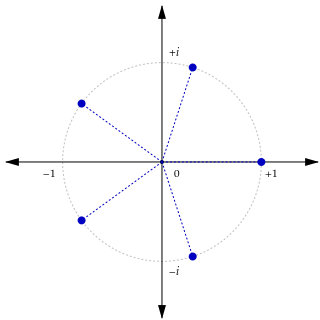In mathematical logic and computer science, the Kleene star is a unary operation, either on sets of strings or on sets of symbols or characters. In mathematics it is more commonly known as the free monoid construction. The application of the Kleene star to a set V is written as V*. It is widely used for regular expressions, which is the context in which it was introduced by Stephen Kleene to characterize certain automata, where it means "zero or more".
- If V is a set of strings, then V* is defined as the smallest superset of V that contains the empty string ε and is closed under the string concatenation operation.
- If V is a set of symbols or characters, then V* is the set of all strings over symbols in V, including the empty string ε.
In theoretical computer science and formal language theory, a regular language is a formal language that can be expressed using a regular expression, in the strict sense of the latter notion used in theoretical computer science.
In mathematics, a semigroup is an algebraic structure consisting of a set together with an associative binary operation.

In abstract algebra, a generating set of a group is a subset such that every element of the group can be expressed as a combination of finitely many elements of the subset and their inverses.
In mathematics, a Kleene algebra is an idempotent semiring endowed with a closure operator. It generalizes the operations known from regular expressions.
In abstract algebra, a semiring is an algebraic structure similar to a ring, but without the requirement that each element must have an additive inverse.
In mathematics and computer science, the Krohn–Rhodes theory is an approach to the study of finite semigroups and automata that seeks to decompose them in terms of elementary components. These components correspond to finite aperiodic semigroups and finite simple groups that are combined together in a feedback-free manner.
The generalized star-height problem in formal language theory is the open question whether all regular languages can be expressed using generalized regular expressions with a limited nesting depth of Kleene stars. Here, generalized regular expressions are defined like regular expressions, but they have a built-in complement operator. For a regular language, its generalized star height is defined as the minimum nesting depth of Kleene stars needed in order to describe the language by means of a generalized regular expression, hence the name of the problem.
In mathematics, an aperiodic semigroup is a semigroup S such that every element x ∈ S is aperiodic, that is, for each x there exists a positive integer n such that xn = xn + 1. An aperiodic monoid is an aperiodic semigroup which is a monoid.
In mathematics and computer science, the syntactic monoidM(L) of a formal language L is the smallest monoid that recognizes the language L.
In algebra, a transformation semigroup is a collection of functions from a set to itself that is closed under function composition. If it includes the identity function, it is a monoid, called a transformationmonoid. This is the semigroup analogue of a permutation group.
In mathematics, particularly in abstract algebra, a semigroup with involution or a *-semigroup is a semigroup equipped with an involutive anti-automorphism, which—roughly speaking—brings it closer to a group because this involution, considered as unary operator, exhibits certain fundamental properties of the operation of taking the inverse in a group: uniqueness, double application "cancelling itself out", and the same interaction law with the binary operation as in the case of the group inverse. It is thus not a surprise that any group is a semigroup with involution. However, there are significant natural examples of semigroups with involution that are not groups.
In computer science, more precisely in automata theory, a recognizable set of a monoid is a subset that can be distinguished by some morphism to a finite monoid. Recognizable sets are useful in automata theory, formal languages and algebra.
In mathematics and computer science, a rational series is a generalisation of the concept of formal power series over a ring to the case when the basic algebraic structure is no longer a ring but a semiring, and the indeterminates adjoined are not assumed to commute. They can be regarded as algebraic expressions of a formal language over a finite alphabet.
In mathematics, and more precisely in semigroup theory, a variety of finite semigroups is a class of semigroups having some nice algebraic properties. Those classes can be defined in two distinct way, using either algebraic notions or topological notions. Varieties of finite monoids, varieties of finite ordered semigroups and varieties of finite ordered monoids are defined similarly.

